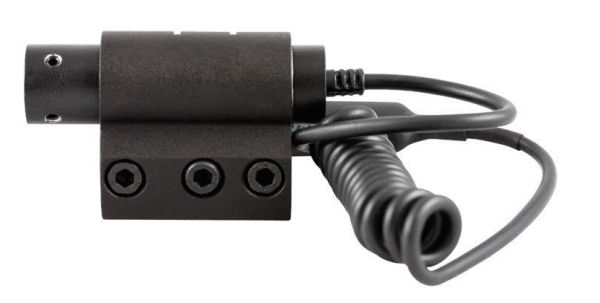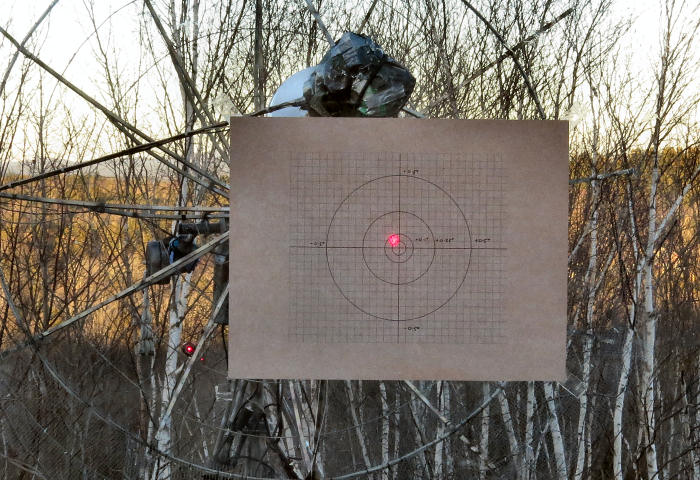EME Antenna Alignment
A critical part of EME operation is knowing exactly where your antenna is pointing. A 3m dish at 1296 has a 3dB beamwidth of around 6 degrees. This doesn't mean you need to be within 6 degrees of the moon, it doesn't even mean you need to be within 3 degrees of the moon (the half beam width). In fact you really need to be within 1 degree of the moon if you want to get close to the maximum signal. A 1 degree pointing error will result in a signal loss of less than 0.5dB. If you're 2 degrees off the moon you'll lose about 1.5dB and if you're 3 degrees off you'll lose close to 3dB. The same numbers would be true for any antenna with a gain of around 27-28dBm. On 432, with 4 x 9-wavelength yagis, you'd want to be within about 2 degrees of the moon to maximize gain (3dB beamwidth would be around 12 degrees).
So how to you calibrate your dish pointing system and how do you know when it's out of calibration?
Probably the best way to get a single point calibration is by peaking the system on sun noise. A program like EMECalc will give you the Elevation and Azimuth of the sun at any time. If you peak sun noise, you know exactly were your antenna is pointed and you can compare your EL and AZ readout with the sun's known position. Of course that only gives you a since point. If you do this throughout a day, you can get multiple points. If your main support mast is truly vertical and your AZ and EL axes are at exactly 90 degrees and your AZ and EL readout systems are accurate and linear, then you only need a single calibration point. Even if everything isn't perfectly aligned, as long as you know your deviation from the expected reading at any point, you can compensate and you still only need a single calibration point. However to get that correction data in the first place, you need a multi point calibration.
So that's the first step. Track the sun, peak sun noise, and compare the reading you get on your AZ and EL readouts to the numbers generated by EMECalc. You could, in principle, do the same thing using a compass and inclinometer, if you trust the compass and inclinometer to be accurate enough. That assumes your main lobe is exactly aligned with the bore-sight axis of your antenna though, and that's not always true. Better to peak on sun noise.
That will get you pretty well calibrated, at least on the day you make the measurements, but how do you know that you're still well calibrated at some future time? Calibration required the sun to be above the horizon and somewhere you can see it and that's not always true. AZ/EL system can suffer from mechanical slippage, lost pulses in pulse counting systems, electronic glitches in control software and probably a host of other factors.
So what to you do in the middle of the night when signals seem weaker than they should be or aren't there at all? How do you know you're actually pointed where you think you are? I solved this problem using a laser pointer that I can activate from the operating position (don't want to have to go outside in sub zero temperatures, rain, snow or other nasty weather!).

You can find a wide variety of switch operated laser sights on eBay at prices form $10 to $50. There are also a wide variety of Laser pointers which can be modified to do the same task.

The low cost laser pointers as pictured above come in red, green and blue. The blue modes are 405nm, which is almost UV. They do not appear very bright and wouldn't be suitable for this application. The green version is very bright, but draws about 300mA. It may not last indefinitely if operated continuously since at that bower and current draw it generated heat and there's limited heat fink capacity in the pointer housing. It is very bright though! The red version draws around 20ma and though it's not as bright as the green version, it seems fine left on continuously. With only 20mA current draw it's probably not generating much hear.
On my dish I have mounted a remotely operated laser pointer. It's one intended for use as a gun sight, but you could use pretty much anything as long as you can remotely operate it and put it in a weatherproof housing. It's attached to the dish with an angled bracket so that when the dish is at a certain fixed position (in my case 180 degrees azimuth and 20 degrees elevation) the beam hits a target on the inside of the shack window. If the laser hits the center of the target and the AZ readout reads 180 degrees and the Elevation readout reads 20 degrees, all is well. If it doesn't, I move the dish until it does, then reset my Azimuth to 180 degrees and my Elevation to 20 degrees. At that point I now know my antenna is pointing where the readouts tell me it's pointing. If you don't have line of sight to your antenna you could have the laser point at something you can see, or if you don't have any windows I guess you could use a remote camera to view the target (or worst case actually go outside and see where the beam is pointing).
Here's a picture of the system in action:

The circles are 0.1°, 0.2°,0.5° and 1° in diameter.
Any time I fire up the 1296 EME system I can check the antenna pointing accuracy as part of the startup process. If during operation I suspect I'm not hearing as well as I should, it takes less than a minute to check out if the dish is pointing where it should be, and if it isn't, re-calibrate my AZ and EL readout, all without leaving my chair!
.jpg)